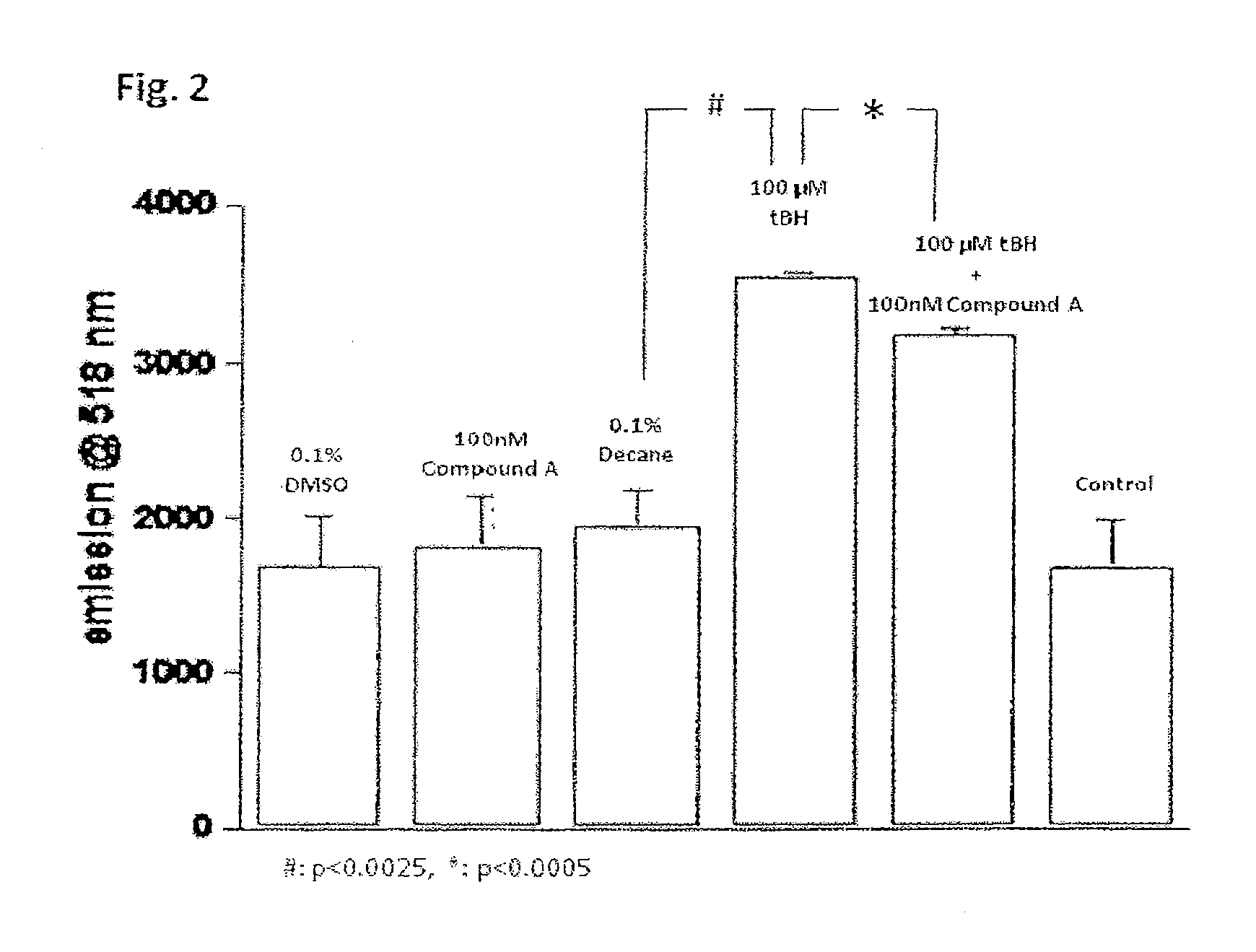Method for treating macular degeneration
a technology of macular degeneration and composition, which is applied in the direction of biocide, drug composition, and elcosanoid active ingredients, etc., can solve the problems of macula loss of function, substantial functional limitations, and no known cure for dry amd
- Summary
- Abstract
- Description
- Claims
- Application Information
AI Technical Summary
Benefits of technology
Problems solved by technology
Method used
Image
Examples
example 1
Method
[0135]Human retinal pigment epithelium cells (ARPE-19 cells, purchased from American Type Culture Collection (ATCC)) were used in the study. ARPE-19 cells were grown on Corning Transwell 0.4 μm pore size filters (Corning Incorporated, NY, USA) in Dulbecco's modified Eagles medium containing 10% fetal calf serum. Trans-Epithelial Resistance (TER) of the cultured cells was determined using an EVOM volt-ohm meter. The TER of the cultured cells was determined by subtracting the resistance value measured with the filter alone from the value measured with the cultured cells.
[0136]The cells were grown until they reached a TER of approximately 50 Ohm / 1.2 cm2. They were then treated with 100 μM tert-butyl hydroperoxide (tBH) in 0.1% decane, 100 nM Compound A (isopropyl unoprostone, i.e. 13,14-dihydro-15-keto-20-ethyl-PGF2α isopropyl ester) in DMSO (0.1% final DMSO), or a combination of tBH plus Compound A. TER was determined at 0, 6, 18, 24 and 48 hours after the treatment. Result is s...
example 2
[0141]Protection by Compound A from light induced cell death in pyridinium bis-retinoid (A2E) containing retinal pigment epithelium (RPE) cells
[0142]Method
[0143]Human retinal pigment epithelium cells (ARPE-19 cells) were used in the study. ARPE-19 cells were maintained in DMEM / F12 medium (supplemented with 10% FBS and 1% Penicillin-Streptomycin Mixed Sol.) in 25 cm2 or 75 cm2 culture flask. For the experiment, the cells were seeded on multi-well chamber slides. After confirming the cells adhered to slide, the media were changed to pyridinium bis-retinoid (A2E) containing culture medium and the cells were cultured for 5-14 days The media were changed to phosphate buffered saline (containing A2E), and then the cells were exposed to blue light (430 nm) delivered from a halogen source for 20 min. Compound A dissolved in dimethyl sulfoxide was added 1 hr before the light: exposure (the final concentration was 10 and 50 nM). After the light exposure, the cells were cultured in the DMEM / F1...
formulation example 1
[0147]Ophthalmic solution was obtained by dissolving the ingredients in an amount shown below (w / v %) in purified water and filled in a sterilized low density polyethylene (LOPE) container under sterile condition (1 drop: approximately 35 μL).[0148]0.15% 13,14-dihydro-15-keto-20-ethyl-PGF2α isopropyl ester (isopropyl unoprostone)[0149]1.0% polyoxyethylenesorbitan monooleate[0150]1.0% mannitol[0151]1.9% glycerin[0152]0.05% edetate disodium[0153]0.003% benzalkonium chloride
PUM
| Property | Measurement | Unit |
|---|---|---|
| pore size | aaaaa | aaaaa |
| concentration | aaaaa | aaaaa |
| colors | aaaaa | aaaaa |
Abstract
Description
Claims
Application Information
 Login to View More
Login to View More - R&D
- Intellectual Property
- Life Sciences
- Materials
- Tech Scout
- Unparalleled Data Quality
- Higher Quality Content
- 60% Fewer Hallucinations
Browse by: Latest US Patents, China's latest patents, Technical Efficacy Thesaurus, Application Domain, Technology Topic, Popular Technical Reports.
© 2025 PatSnap. All rights reserved.Legal|Privacy policy|Modern Slavery Act Transparency Statement|Sitemap|About US| Contact US: help@patsnap.com



